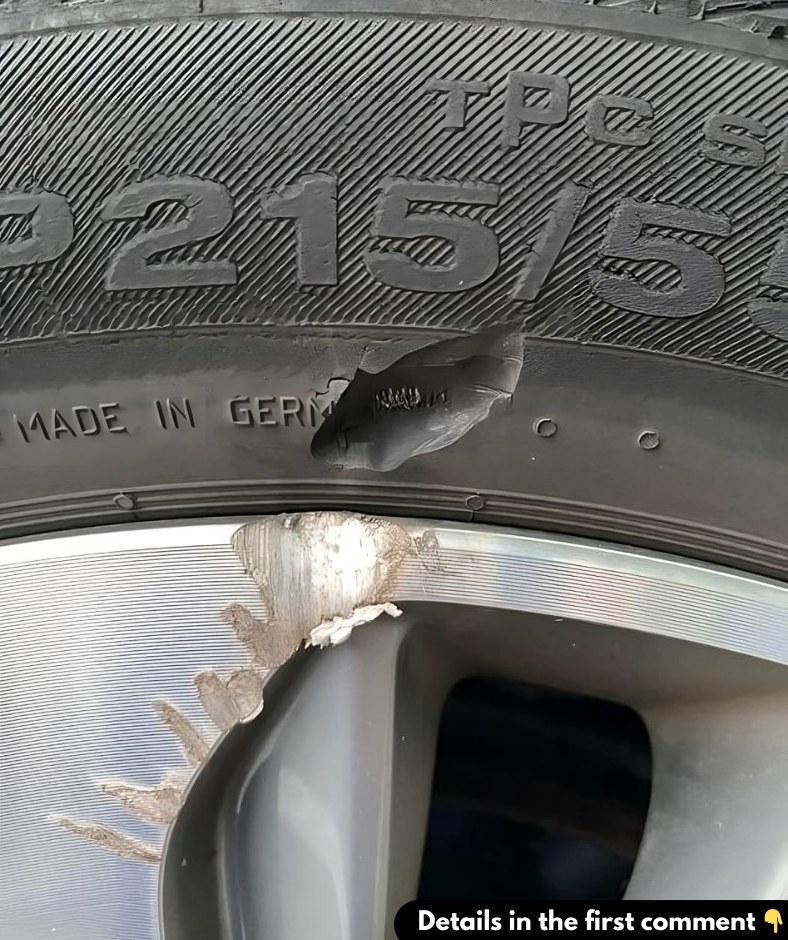The sidewall of a tire is particularly vulnerable because, unlike the thicker tread area designed for road contact, the sidewall is thinner. Damage to this area often appears as cuts, punctures, or cracks that can seriously affect the tire’s performance and safety.

What Causes Sidewall Damage?
Sidewall cuts are typically the result of scraping against curbs, sharp debris, or rough surfaces. Underinflated tires are especially susceptible since they flex more, making them prone to cuts. This is why it’s crucial to regularly check your tire pressure to avoid unnecessary damage.
Why Sidewall Damage Should Not Be Ignored
Sidewall damage is more than just a cosmetic issue; it’s a significant safety risk. Unlike punctures in the tread area that can often be patched, sidewall cuts cannot be safely repaired. The sidewall endures constant stress, making it more vulnerable to blowouts, especially at high speeds. If you notice a deep cut in the sidewall, it’s best to replace the tire immediately to avoid potential accidents.
Curb Rash on Rims: What You Need to Know
Curb rash refers to the scratches or scuffs that occur on the rim when a car grazes a curb. This can happen during parking or while making tight turns.
Why Do Rims Get Damaged?
When the sidewall comes into contact with a curb, the rim often takes the brunt of the impact. This is common in narrow streets or when parking too close to curbs. While most curb rash is superficial, it can lead to deeper issues over time.
Is Curb Rash a Serious Issue?
While curb rash doesn’t present an immediate safety concern like sidewall damage, severe scratches can lead to long-term problems. Deep gouges might affect the rim’s ability to seal properly with the tire, potentially causing slow air leaks. Cosmetic damage can usually be repaired, but if the rim is deeply scratched or bent, it might be best to replace it to maintain safe driving conditions.
What to Do If You Spot Damage on the Tire or Rim
Discovering damage on your partner’s car can be alarming, but staying calm and taking the right steps is key. Here’s how to handle it:
- Inspect the Tire Sidewall
Look closely for any cuts or cracks, especially those deep enough to expose the inner layers of the tire. If you find significant damage, avoid driving on that tire and call for a tow to a nearby tire shop. - Check Tire Pressure
A cut in the sidewall can cause the tire to lose pressure. Use a gauge to check the air levels. If it’s low, inflate the tire temporarily and drive slowly to a service center. - Assess the Rim’s Condition
Look for scratches, bends, or cracks on the rim. Minor scratches can often be fixed, but significant damage requires professional repair. If the rim is bent or cracked, it’s safer to replace it to avoid potential handling issues.
Why Tire Replacement Is Necessary for Sidewall Damage
If you notice any significant damage to the tire’s sidewall, replacing the tire is non-negotiable. Here’s why:
- Repairs Aren’t Reliable: Sidewall repairs are unsafe due to the constant stress this area experiences.
- High Risk of Blowouts: Damaged sidewalls are prone to sudden blowouts, especially at high speeds.
- Immediate Replacement Needed: Continuing to drive on a damaged sidewall endangers everyone in the car, so replacing it is the only safe option.
Addressing Curb Rash: Should You Repair or Replace?
While curb rash is usually a cosmetic concern, it’s still worth addressing to keep both the car’s appearance and function in top shape.
DIY Repair Kits
For light scratches, there are DIY kits available with sandpaper, fillers, and paint to smooth out surface-level damage. However, these kits only work for minor cosmetic issues.
Professional Rim Repair
If the scratches are more severe, it’s best to consult a professional. They can restore the rim using techniques like sanding, buffing, and repainting to get it looking as good as new.
When to Replace the Rim
Bent or cracked rims should be replaced as soon as possible to avoid handling problems, vibrations, or uneven tire wear. Driving on a damaged rim can compromise safety.
Could Repeated Damage Indicate a Bigger Problem?
While tire and rim damage can happen to anyone, repeated incidents might point to underlying issues:
- Driving Habits: Frequent sidewall cuts or curb rash might suggest a habit of driving too close to curbs or making overly tight turns. It may be worth discussing safer driving practices to prevent future damage.
- Alignment or Suspension Issues: Regular tire damage could signal problems with your car’s alignment or suspension, so a check-up is recommended.
- Parking Choices: If parking in tight or busy areas is a regular occurrence, it increases the risk of damage. Opt for wider parking spaces whenever possible to reduce incidents.
Conclusion: Quick Action Ensures Safety
Noticing damage like sidewall cuts or curb rash can be concerning, but prompt action is essential for safety. While sidewall damage requires immediate tire replacement, curb rash can often be repaired if caught early. Being proactive in addressing these issues, encouraging safer driving habits, and choosing parking spots wisely can go a long way in keeping the car in optimal condition. Regularly checking your tires and rims ensures a smoother, safer ride for everyone on board.



